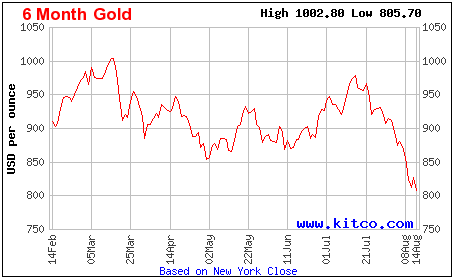Paulson meant that he was waiting for the US-lead depression to catch up with the rest of the world and bring down rates in Pounds, Euros, Yen and Australian dollars. He’s a genius after all. It’s working:
Source: http://quotes.ino.com/chart/?s=NYBOT_DX
Even gold, that running vote of confidence in paper money, has backed well off the disconcerting 4-digit level:
Source: Kitco.com
How could people suddenly have such a preference for the dollar again? Don’t they know that it, like the Constitution, is just a goddamned piece of paper? Well, Paulson won’t admit this part of the policy, but you may have heard lately about people and companies going broke. Broke means no money (such as dollars). Since dollars accounted for a huge share of the bad loans made in the bubble, the implosion of that debt is akin to a shortage of dollars.
The dollars were never really there, just debt, but when you get a loan, it sure feels and works like money. And when it comes time to pay it back, money is what you need. Right now, nobody seems to have much of it, so those who do are getting the sense that they should hang onto it. That means a slower velocity of money (the pace with which it changes hands), which is deflationary by even by mainstream economists’ definition (M V = P Q).
So, who wants to guess how much longer Peter Schiff can hold out with his inflation case?



Since the government’s own wildly understated figures showed inflation at a 17 year high earlier this week, who knows?
I think the worst of all worlds may be possible in this cycle, that is, inflation AND deflation. How is that possible? Rapidly collapsing asset values for stocks, bonds, real estate, and some commodities, while at the sime time we have rapidly rising prices for food, medicine, electricity and the other essentials of life.
Those government numbers are a bad way to measure inflation, but the bias is not all one-way. For instance, they reported gas prices up last month over June, when they were really down, because of their seasonal adjustment. And I don’t think they have factored in the fall in housing costs, just like they damped down the effect of the rise in housing. Nor do they use the real prices people are paying for new and used cars this year.
But the worst thing about using CPI as the main inflation gauge is that price movements are just the result of inflation or deflation. They are a lagging indicator.
But I have to disagree that you can have inflation and deflation at the same time. Of course you can have some prices going up while others come down, but the net change money and credit across the economy is either positive or negative. I don’t think there can be much dispute that the sum of money and credit is contracting fast, due to the pace of credit destruction.
So because money and credit are deflating, whatever increased spending that results from higher food or fuel prices is more than offset by cutbacks in housing and discretionary outlays.